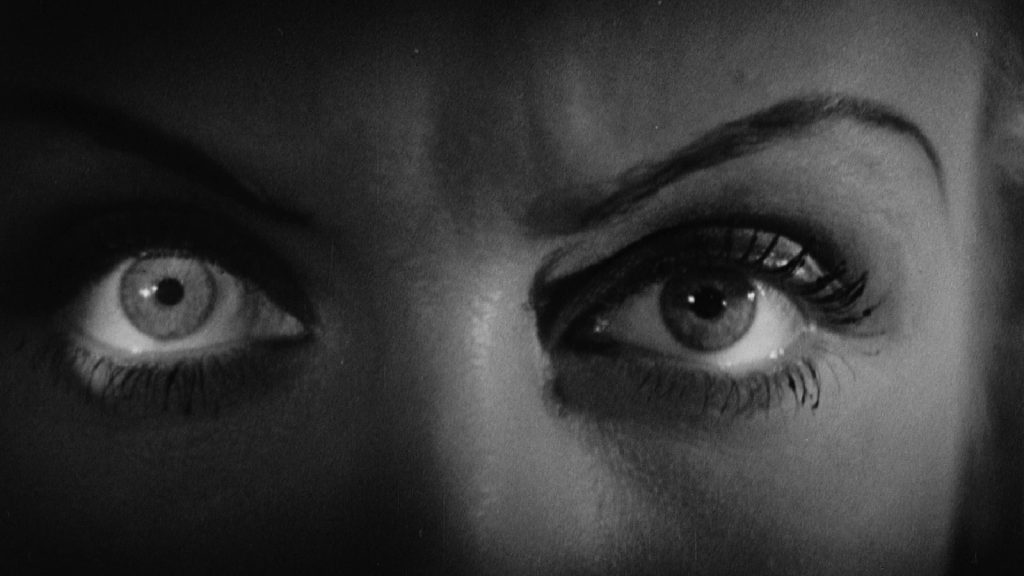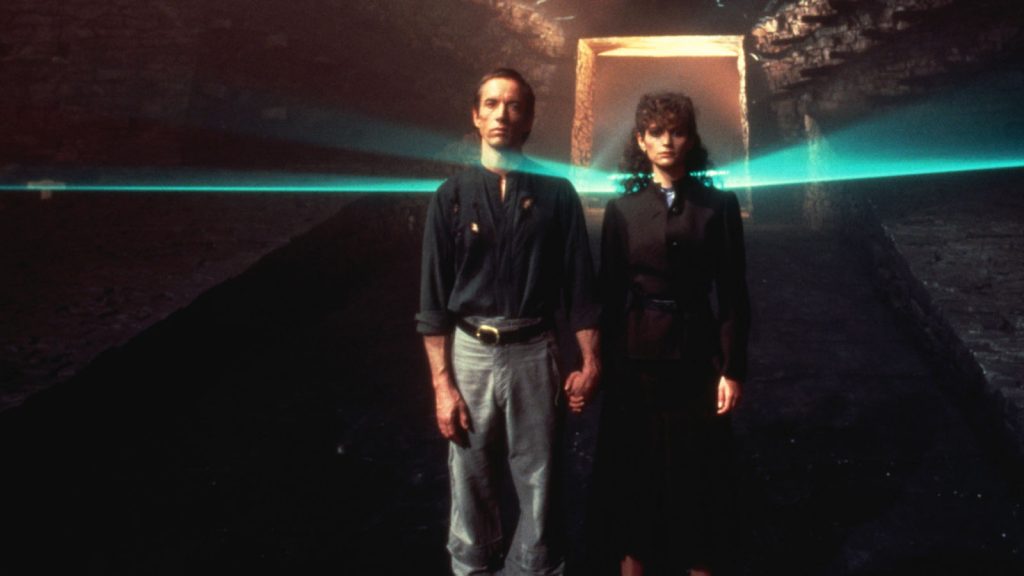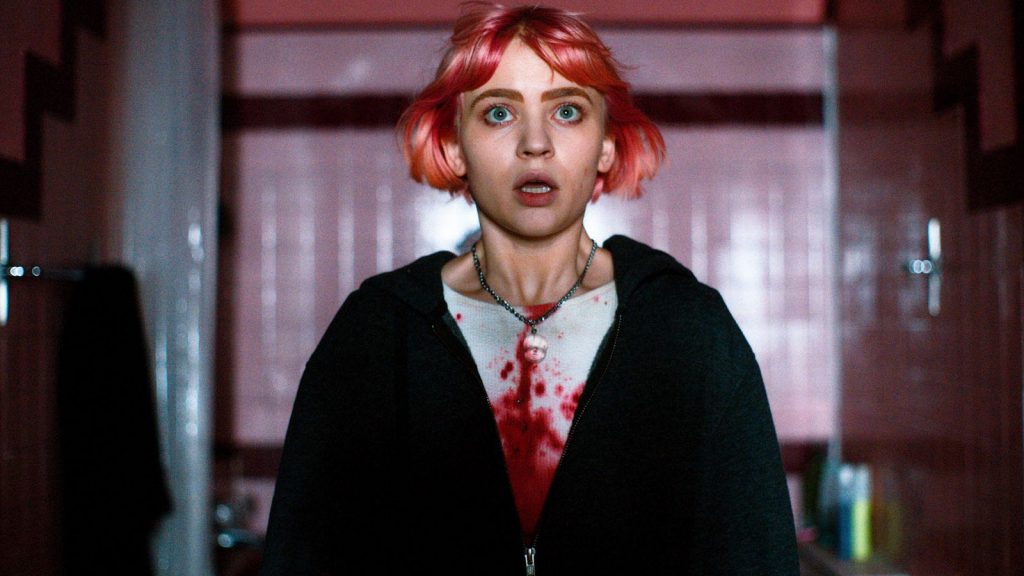
To love Hammer horror films is to love the look of them and probably also have an abiding affection for the fall, given that it always seems to be autumn in the world of Hammer. The forest through which many a damsel and barmaid has been forced to flee is perpetually carpeted with leaves. Trees resemble ranks of skeletons well-positioned to watch the grim action. Faded browns and muted oranges hold dominion. Nothing is outrightly green. We can practically smell the decaying vegetation in the air. Soon, winter will wrap her icy grip around all, but we’ll be gone by then, perhaps off in a different Hammer film, where it will also, of course, be autumn.
Still, certain Hammer works are more autumnal than others, and in this regard, none out-autumns Terence Fisher’s The Gorgon from 1964. There’s usually a conversational pecking order of films for the studio’s devotees: the Dracula and Frankenstein undertakings are cited first, especially if the cast boasts both Peter Cushing and Christopher Lee. Then we have the robust reboots of the classic fare, albeit from other sources: The Mummy, The Curse of the Werewolf, The Hound of the Baskervilles. Being as oriented to revitalizing beloved monsters as the studio was, other Hammer pictures could get lost in the splashy shuffle, and, as with The Gorgon, can do with a bit of rescuing.
The Gorgon is a mood piece. This is one of those movies that makes you think you should put on a jacket or vest—though not your winter coat—while watching. The sun hangs low in the sky, like it barely clears the treetops. Time is compacting, slowing down—the same as the life within the gorgon’s victims. It’s a cinematic nocturne for autumn and one of the few films in which you can actually hear the scrape from the edges of wind-scuttled leaves on the ground.

Veterans Lee and Cushing are present and accounted for, men of science, though one has a greater interest in the pleasures of the flesh. Hammer was known for buxom innocents who you weren’t supposed to believe were very chaste at all—which was part of the “sexy” appeal at the time—but their young male leads were often likable, grounded fellows who tried to do the right thing. That would be Paul (Richard Pasco) in The Gorgon, to whom it falls to dispatch the spirit that can take over the body of someone like his beloved and turn those who look where they ought not to into rock.
The early scene in which Paul’s father returns home after being lured, Circe-style, out into the woods by the gorgon and drafts a letter warning his son of this malevolence is among the most moving in any Hammer picture. Hammer didn’t really “do” feelings normally. Adventure, yes, and the necessary daring when someone had to climb the big mountain to take on Dracula in his castle, but Hammer wasn’t often heartfelt. The father, who knows he’s turning to stone, tries to say all he needs to say while able. It’s like a race against geology that also happens to have the supernatural in its corner, which makes us respect this very human effort all the more.
Hammer had no need to have the characters you were rooting to emerge intact, and The Gorgon is a prime example. Autumn has a solemnity to it; eventually, that last leaf, holding so fast to the tree, will fall. Another leaf will be back in its place later, and the process repeats. The Gorgon is Hammer’s gusty celebration of life and death foregathering in the autumn as they do in no other season to this marked degree. Is it any wonder that this studio decided that fall was to be its forever season of horror? 🩸

is the author of eight books, including the story collection, If You [ ]: Fabula, Fantasy, F**kery, Hope, a 33 1/3 volume on Sam Cooke’s Live at the Harlem Square Club, 1963, Meatheads Say the Realest Things: A Satirical (Short) Novel of the Last Bro, and a book about 1951’s Scrooge as the ultimate horror film. His work has appeared in Harper’s, The Atlantic, Rolling Stone, The New York Times, Vanity Fair, The Daily Beast, Cineaste, Film Comment, Sight and Sound, JazzTimes, The New Yorker, The Guardian, and many other venues. He’s completing a book called And the Skin Was Gone: Essays on Works of Horror Art. His website is colinfleminglit.com, where he maintains the Many Moments More journal, which, at 2.7 million words and counting as of autumn 2023, is the longest sustained work of literature in history.
For all of Hammer’s reliance on its tried-and-true monsters, the studio did a fair amount of foraying. Hammer horror could take myriad forms beyond the familiar Dracula...
BY COLIN FLEMING | December 31, 2024
It’s quite likely that my first taste of narrative horror was provided by Tales from the Crypt, the luridly tongue-in-cheek anthology series that ran from 1989-96 on HBO.
BY STEVEN MEARS | December 22, 2024
Love—or what we call love—produces a lot of lip service, which isn’t a reference to kissing. We proclaim our dedication to another, though in reality—if our typical future behavior is any...
BY COLIN FLEMING | February 13, 2025

This pre-Code offering packs a lot of story into its typically brisk running time, with several plot threads weaving together a (not always successful) tapestry of spooky and criminal doings.
READ MORE >
BY ANN OLSSON | Month 00, 2021

In what could be the fastest-resulting rape revenge movie, a drunken lout brutally forces himself on Ida, the young woman who doesn't return his affections, during a party over Labor Day.
READ MORE >
BY LAURA KERN | Month 00, 2021

Beast is a lot of movies in one package - fractured fairy tale, belated-coming-of-age story, psychological drama, regional horror film - but above all it's a calling card for its leading lady, Jessie Buckley.
READ MORE >
BY LAURA KERN | Month 00, 2021